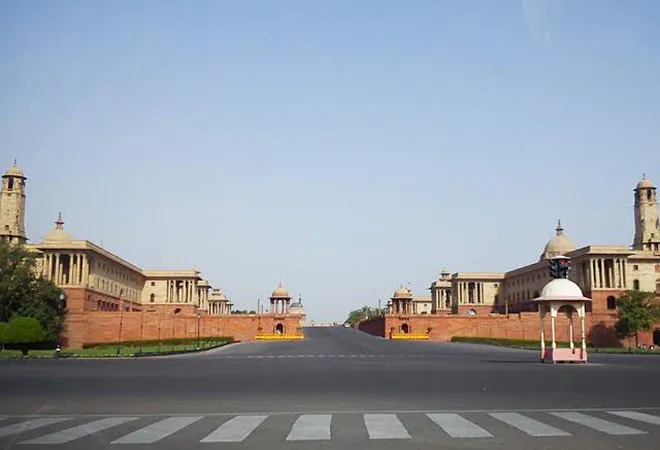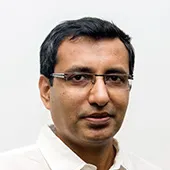
This piece is part of the series,
India @75: Assessing Key Institutions of Indian Democracy.
The Indian Parliament is a very different institution from when Jawaharlal Nehru gave his memorable ‘Tryst With Destiny’ speech in 1947. Nearly 60 years later
in 2008, three members of the Parliament waved bundles of cash inside the House during a no-confidence vote alleging that they had been bribed to vote for the government. In the 1950s, the Indian Parliament was often seen as an example for the countries that had just thrown off the colonial yoke. In 1952, soon after the first Indian general elections, the Manchester Guardian commented, “Parliamentary institutions have not had a very good time in Asia… All that is happening in Asia throws a spotlight on the Parliament in Delhi as the one institution of the kind which is working in an exemplary way.” British political scientist W.H. Morris-Jones had concluded his study of Parliament, published in the 1950s, by noting, “The story told here is unmistakably a story of success”. There would be few takers now for such a view. Disruption of the proceedings is now routine, the number of hours that the Parliament sits and the volume of legislations passed have both seen a dramatic decline in recent times, as have debates and committee scrutiny.
One of the brighter aspects of the story of the Parliament is its representativeness.
One of the brighter aspects of the story of the Parliament is its representativeness. Post-independence, in 1952, the Parliament was mostly a stronghold of lawyers who were associated with the freedom movement and legislative bodies in pre-independent India. However, now the Parliament has become
more representative of Indian society. < lang="EN-US">This is partly due to reservation or quotas for the Scheduled Castes and Scheduled Tribes. This is also due to the continuous deepening of democracy, which has been aided by a number of forces including the implementation in 1989 of the Mandal Commission Report’s recommendation of quotas for the Other Backward Classes (OBCs). The diversity has, however, been accompanied, in recent years, by fewer members from minority religious groups, particularly the Muslim community, a large number of MPs belonging to political dynasties, an increasing number of wealthy MPs and those with criminal backgrounds. While the number of women members has increased, reaching an all-time high in 2019, it is still well below global standards.
< style="color: #000000">< lang="EN-US">Concurrently, there has been an enormous change in the political composition of parliament from one dominated by the Congress to the first non-Congress government in 1977 and subsequently the formation of minority and coalition governments. The transformation from a one-party dominant system to a multi-party one and now again to a nascent one-party system, under the Bharatiya Janata Party (BJP), has fundamentally altered the rules of engagement in the Parliament.
Significance of parliamentary committee system
Another reason for optimism is the functioning of the parliamentary committee system which has been a part of the Parliament right from the beginning, but which expanded significantly since the 1990s. Though much of the analysis of the Parliament is done on the basis of what happens on the floor of the House, the important legislative work takes place in the committees. Besides the financial committees, there are now 24 department-related standing committees (DRSCs), in addition to other standing and ad hoc committees. Unlike the adversarial politics played out publicly on the floor of the Parliament, the committees, composed of members cutting across party lines and from both Houses, are meant to be more cooperative. Moreover, the committee system has been much more in the public eye following the setting up of investigative Joint Parliamentary Committees (JPCs) probing issues of national importance—a
practice first instituted in 1987 to enquire into the Bofors scandal. Another instance was the
JPC to probe the 2G spectrum allotment scam, believed to be one of the biggest corruption scandals in India. Questions, however, remain on the functioning of committees and their efficacy and transparency.
Challenges of this decade
However, there has been a significant change in the parliamentary norms and a sharp upturn in disruptions and protests within the House since the 1980s. While many commentators dismiss such disruptions as a sign of an inefficient and dysfunctional parliament, disruptions need to be seen in the context of the changing social and political composition of parliament as well as the introduction of a live telecast of the entire parliamentary proceedings since2006, which has provided an incentive for grandstanding. The frequency of protests inside the House and the behaviour of MPs possibly represent a clash between the elite and mass cultures, which undermined British parliamentary rituals. They also represent the intrusion of the politics and political theatre of the street into the precincts of the Parliament, which have often adversely affected its deliberative and legislative functions.
The political composition also saw an enormous change, from one dominated by Congress to the first non-Congress government in 1977 and subsequently, the growing presence of minority and coalition governments.
Moreover, criminality and corruption, which are increasingly associated with India’s political class, pose a severe challenge to the legitimacy and accountability of the Parliament. As far back as 1951, an MP in the Provisional Parliament, H.G. Mudgal, was
accused of taking money to ask questions and move amendments in the Parliament. Many years later, the 2008 scandal raised similar crucial questions about the conduct and accountability of MPs. It also raised the question as to whether the privileges of the Parliament are an impediment to accountability and whether there are institutional mechanisms to ensure that the privileges are not abused.
Another startling feature of the Parliament is the large number of MPs with criminal charges against their name. Indeed, as many as 43 percent of MPs in the 17thLok Sabha had
pending criminal cases against their name. This has led the Indian Supreme Court to
pronounce that the “lawbreakers have become the lawmakers.” It is largely due to public interest litigation that the courts have, on more than one occasion, ruled on the eligibility of election candidates and the levels of transparency they should be subject to. Much of this has provided fodder for anti-politician sentiments. Civil society activists such as Anna Hazare successfully used such popular perceptions to agitate for an anti-corruption ombudsman or Lokpal, which was first mooted in the 1960s. Another issue related to ‘corruption’ or the ethics of being a representative is the issue of defection and the ramifications of the 1985 anti-defection legislation. The debate over corruption also provides a window into the friction between the Parliament and the judiciary—a running theme of Indian politics.
Conclusion
In the past 75 years, the Indian Parliament has many achievements to its name despite its growing unpopularity. The parliament reflects the deepening of democracy, which has also had an impact on its functioning. This has, however, led to a fundamental re-imagining of the British parliamentary system and its procedures that the Indian Constituent Assembly opted to follow after independence. At the same time, the Parliament has only fitfully lived up to its responsibility of deliberating on and crafting legislation and ensuring accountability and transparency in government.
The debate over corruption also provides a window into the friction between the Parliament and the judiciary—a running theme of Indian politics.
In recent times, while the Parliament’s
productivity has gone up, it faces several challenges. Amongst the indicators of decline are the sharply dipping number of bills being referred to parliamentary committees; shrinking space for the opposition; an increasing recourse to ordinances; and the
bypassing of the Parliament on several important initiatives.
The views expressed above belong to the author(s). ORF research and analyses now available on Telegram! Click here to access our curated content — blogs, longforms and interviews.



 This piece is part of the series,
This piece is part of the series,  PREV
PREV


